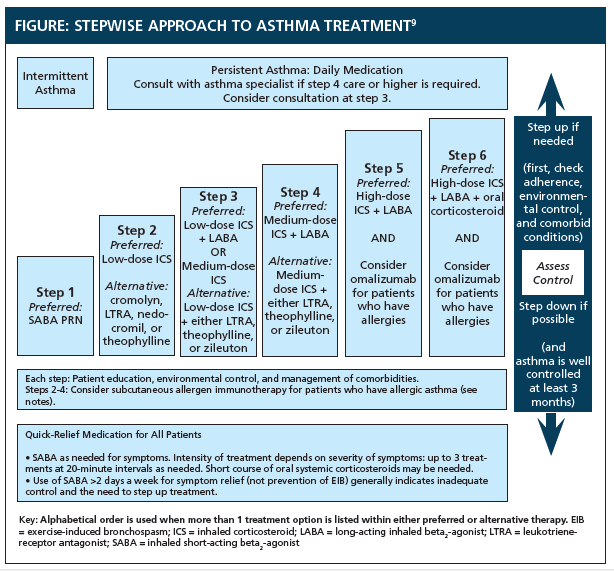| Drug | Mechanism of action | Adverse effects |
| Beta 2 agonists: albuterol, terbutaline, salmeterol, formoterol | Relaxation of smooth muscle in the bronchi by stimulating bronchodilating beta 2 receptors, activation of adenylate cyclase, increased cAMP; Salmeterol and formoterol show greater specificity for beta 2 receptors | Tremors, tachycardia, tolerance, cramps, salmeterol can increase the risk of severe asthma attacks and death |
| Corticosteroids (budesonide, beclomethasone, fluticasone, triamcinolone, prednisone, methylprednisone, prednisolone) | Anti Inflammatory, reduce secretions and mucosal inflammation, decrease the severity and frequency of asthma attacks | Oral candidiasis, cough, adrenal suppression, osteoporosis, growth suppression, peptic ulcers, myopathy, hypertension, Cushing’s syndrome |
| Methylxanthines (theophylline) | Inhibits phosphodiesterase hence prevents the breakdown of cAMP, increases cAMP and cGMPlevels, bronchodilation, decreased release of inflammatory mediators from mast cells; adenosine receptor antagonist | Narrow therapeutic index, tachycardia, arrhythmias, sudden death, CNS excitation, nervousness, insomnia, tremors, seizures, gastric upset |
| Cromolyn, nedocromil | Inhibit release of inflammatory mediators from mast cells, suppression of leukocyte chemotaxis; Used to prevent asthma, prevent exercise and allergen induced bronchoconstriction | Cough, unpleasant taste, dermatitis, myositis, generally well tolerated |
| Zileuton | It inhibits the enzyme 5 lipoxygenase that is used in the synthesis of leukotrienes | Headache, nausea, gastric upset, myalgia, Churg Strauss syndrome |
| Leukotriene modifiers (montelukast, zafirlukast) | Antagonize the action of leukotriene on the airways by blocking leukotriene receptors; Effective in aspirin induced asthma also | Headache, nausea, gastric upset, myalgia, Churg Strauss syndrome, elevation of liver enzymes |
| Muscarinic antagonists (ipratropium, tiotropium) | Block muscarinic receptors in the airways, decrease bronchoconstriction and mucosal secretion | Anticholinergic effects especially in elderly, cough, dry mouth, throat irritation, urinary retention, tachycardia, delirium, blurred vision |
| Monoclonal antibodies (omalizumab) | It is a humanized recombinant monoclonal antibody to IgE that blocks the binding of IgE to mast cells, preventing degranulation | Injection site reactions, risk of malignancies, rarely anaphylaxis, high cost |

Sign up for free to take 1 quiz question on this topic